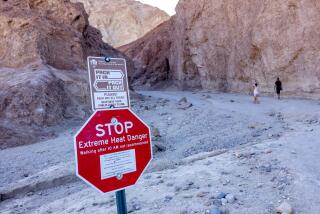
- Share via
For the first time since record keeping began, Earth has surpassed a critical temperature threshold that scientists have long warned could unleash the worst effects of climate change.
On Friday, the planet soared 2.07 degrees Celsius above preindustrial levels, or the 1850 to 1900 average, according to Europe’s Copernicus Climate Change Service.
Aggressive and impactful reporting on climate change, the environment, health and science.
Two degrees Celsius — or 3.6 degree Fahrenheit — is the internationally agreed upon upper limit of warming established by the 2015 Paris climate agreement. The agreement seeks to hold the increase in the global temperature to well below that limit, and preferably below 1.5 degrees Celsius, in recognition that “this would significantly reduce the risks and impacts of climate change.”
Copernicus officials shared the finding Monday in a post on X. Deputy director Samantha Burgess said preliminary data also show that the global temperature on Saturday measured 2.06 degrees Celsius above preindustrial levels, indicating that there are “now two November 2023 days” where the temperature exceeded the benchmark.
Scientists have long warned that sustained warming of 1.5 degrees or more will lead to cascading risks for human and planetary systems, including negative impacts on ecosystems, biodiversity, water supplies and food security. Warming land and ocean temperatures are already contributing to sea level rise, melting ice sheets and increased hazards such as heat waves, drought and extreme precipitation, according to the Intergovernmental Panel on Climate Change.
While significant challenges are expected for many regions and systems at 1.5 degrees of warming, “risks would be larger at 2 degrees Celsius of warming and an even greater effort would be needed for adaptation to a temperature increase of that magnitude,” the IPCC says.
However, caution is warranted when it comes to a single day’s data, said Gavin Schmidt, director of NASA’s Goddard Institute for Space Studies. He noted that the terms of the Paris climate agreement are more concerned with sustained, years-long warming at those temperatures.
Last month was the hottest October ever recorded, with officials indicating that the planet is growing perilously close to a tipping point on global warming.
Surpassing 2 degrees once or twice does not indicate a point of no return, Schmidt said. But the record-setting weekend is noteworthy in the context of larger trends.
“Is the planet warming? Yes,” Schmidt said. “Are we going to see days above 2 degrees before we get weeks above 2 degrees, before we get to months, before we get to years? Yes. And is the planet right now going through an exceptional warming spurt? The answer is yes, yes it is. 2023 is proving to be exceptional in both the impacts and in these metrics.”
Indeed, Monday’s announcement came only weeks after officials warned that 2023 is on track to become Earth’s warmest year on record following a record-hot June, July, August, September and October. The latest milestone is noteworthy, but also a reminder that it’s not too late to change course, said Zeke Hausfather, a research scientist with Berkeley Earth.
“It’s a warning that we’re starting to get uncomfortably close,” Hausfather said. “Certainly the fact that we were seeing months on end of 1.5 degrees [warming] is a sign that that target is quickly slipping by the wayside, and if we keep being complacent for the next decade, we’re going to be in the same place regarding 2 degrees.”
The majority of the warming is attributed to greenhouse gas emissions from the burning of fossil fuels, he and other experts say. But this year’s strengthening El Niño is also playing a role, as the climate pattern is associated with warmer global temperatures.
‘Every 10th of a degree of warming matters.’ Here are six key takeaways from the new National Climate Change Assessment, released this week by the White House.
Researchers have also posited that last year’s eruption of the Hunga Tonga-Hunga Ha’apai volcano in the South Pacific may be contributing to extreme warming this year. The eruption shot record amounts of heat-trapping water vapor into the atmosphere.
Additionally, a study published this month by renowned climate scientist James Hansen said a recent change in aerosol shipping regulations could be a contributing factor. The regulations reduced the amount of sulfur allowed in fuels in an effort to improve air quality, but the change may have had an unintended planetary warming effect because the aerosols were reflecting sunlight away from Earth.
Hausfather said the volcano eruption and the change in shipping regulations appear to have played a small role in recent warming trends, but not enough to singularly explain how anomalously hot this year has been. That El Niño arrived so quickly after a rare three consecutive years of La Niña, its cooling counterpart, may have made some of its warming effects show up earlier and stronger than in previous years.
“Scientists don’t have all the answers right now,” he said. “Were going to be doing a lot of research in the next few years to dig into the exact drivers, but it certainly has been an exceptionally warm year so far — and it’s going to be the warmest year on record by a fairly large margin.”
Not all hope is lost, however. The Fifth National Climate Change Assessment, released last week by the White House, underscored that every fraction of a degree of warming added or averted will make a difference.
The report “clearly shows that per 10th of a degree of avoided warming, we save, we prevent risk, we prevent suffering,” Katharine Hayhoe, one of its authors, told The Times.
The news also comes ahead of COP28, an international climate conference that will begin later this month in Dubai.
“We still have time,” Hausfather said, “to avoid the future we got a sneak peek of this past weekend.”
Toward a more sustainable California
Get Boiling Point, our newsletter exploring climate change, energy and the environment, and become part of the conversation — and the solution.
You may occasionally receive promotional content from the Los Angeles Times.










